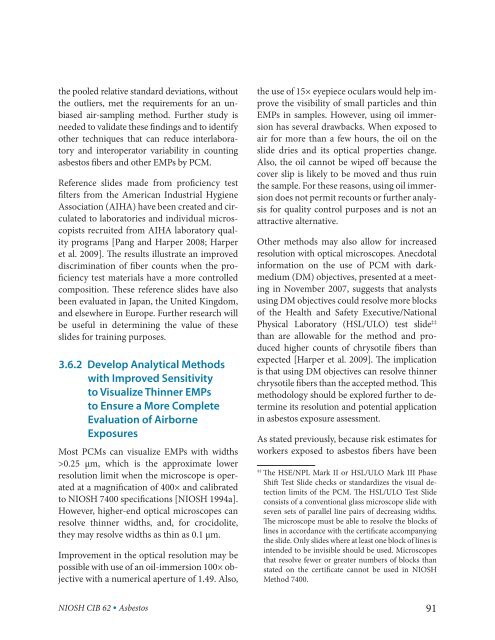Asbestos Fibers and Other Elongate Mineral Particles: State of the ...
Asbestos Fibers and Other Elongate Mineral Particles: State of the ...
Asbestos Fibers and Other Elongate Mineral Particles: State of the ...
- No tags were found...
You also want an ePaper? Increase the reach of your titles
YUMPU automatically turns print PDFs into web optimized ePapers that Google loves.
<strong>the</strong> pooled relative st<strong>and</strong>ard deviations, without<br />
<strong>the</strong> outliers, met <strong>the</strong> requirements for an unbiased<br />
air-sampling method. Fur<strong>the</strong>r study is<br />
needed to validate <strong>the</strong>se findings <strong>and</strong> to identify<br />
o<strong>the</strong>r techniques that can reduce interlaboratory<br />
<strong>and</strong> interoperator variability in counting<br />
asbestos fibers <strong>and</strong> o<strong>the</strong>r EMPs by PCM.<br />
Reference slides made from pr<strong>of</strong>iciency test<br />
filters from <strong>the</strong> American Industrial Hygiene<br />
Association (AIHA) have been created <strong>and</strong> circulated<br />
to laboratories <strong>and</strong> individual microscopists<br />
recruited from AIHA laboratory quality<br />
programs [Pang <strong>and</strong> Harper 2008; Harper<br />
et al. 2009]. The results illustrate an improved<br />
discrimination <strong>of</strong> fiber counts when <strong>the</strong> pr<strong>of</strong>iciency<br />
test materials have a more controlled<br />
composition. These reference slides have also<br />
been evaluated in Japan, <strong>the</strong> United Kingdom,<br />
<strong>and</strong> elsewhere in Europe. Fur<strong>the</strong>r research will<br />
be useful in determining <strong>the</strong> value <strong>of</strong> <strong>the</strong>se<br />
slides for training purposes.<br />
3.6.2 Develop Analytical Methods<br />
with Improved Sensitivity<br />
to Visualize Thinner EMPs<br />
to Ensure a More Complete<br />
Evaluation <strong>of</strong> Airborne<br />
Exposures<br />
Most PCMs can visualize EMPs with widths<br />
>0.25 µm, which is <strong>the</strong> approximate lower<br />
resolution limit when <strong>the</strong> microscope is operated<br />
at a magnification <strong>of</strong> 400× <strong>and</strong> calibrated<br />
to NIOSH 7400 specifications [NIOSH 1994a].<br />
However, higher-end optical microscopes can<br />
resolve thinner widths, <strong>and</strong>, for crocidolite,<br />
<strong>the</strong>y may resolve widths as thin as 0.1 µm.<br />
Improvement in <strong>the</strong> optical resolution may be<br />
possible with use <strong>of</strong> an oil-immersion 100× objective<br />
with a numerical aperture <strong>of</strong> 1.49. Also,<br />
NIOSH CIB 62 • <strong>Asbestos</strong><br />
<strong>the</strong> use <strong>of</strong> 15× eyepiece oculars would help improve<br />
<strong>the</strong> visibility <strong>of</strong> small particles <strong>and</strong> thin<br />
EMPs in samples. However, using oil immersion<br />
has several drawbacks. When exposed to<br />
air for more than a few hours, <strong>the</strong> oil on <strong>the</strong><br />
slide dries <strong>and</strong> its optical properties change.<br />
Also, <strong>the</strong> oil cannot be wiped <strong>of</strong>f because <strong>the</strong><br />
cover slip is likely to be moved <strong>and</strong> thus ruin<br />
<strong>the</strong> sample. For <strong>the</strong>se reasons, using oil immersion<br />
does not permit recounts or fur<strong>the</strong>r analysis<br />
for quality control purposes <strong>and</strong> is not an<br />
attractive alternative.<br />
<strong>O<strong>the</strong>r</strong> methods may also allow for increased<br />
resolution with optical microscopes. Anecdotal<br />
information on <strong>the</strong> use <strong>of</strong> PCM with dark-<br />
medium (DM) objectives, presented at a meeting<br />
in November 2007, suggests that analysts<br />
using DM objectives could resolve more blocks<br />
<strong>of</strong> <strong>the</strong> Health <strong>and</strong> Safety Executive/National<br />
Physical Laboratory (HSL/ULO) test slide ‡‡<br />
than are allowable for <strong>the</strong> method <strong>and</strong> produced<br />
higher counts <strong>of</strong> chrysotile fibers than<br />
expected [Harper et al. 2009]. The implication<br />
is that using DM objectives can resolve thinner<br />
chrysotile fibers than <strong>the</strong> accepted method. This<br />
methodology should be explored fur<strong>the</strong>r to determine<br />
its resolution <strong>and</strong> potential application<br />
in asbestos exposure assessment.<br />
As stated previously, because risk estimates for<br />
workers exposed to asbestos fibers have been<br />
‡‡ The HSE/NPL Mark II or HSL/ULO Mark III Phase<br />
Shift Test Slide checks or st<strong>and</strong>ardizes <strong>the</strong> visual detection<br />
limits <strong>of</strong> <strong>the</strong> PCM. The HSL/ULO Test Slide<br />
consists <strong>of</strong> a conventional glass microscope slide with<br />
seven sets <strong>of</strong> parallel line pairs <strong>of</strong> decreasing widths.<br />
The microscope must be able to resolve <strong>the</strong> blocks <strong>of</strong><br />
lines in accordance with <strong>the</strong> certificate accompanying<br />
<strong>the</strong> slide. Only slides where at least one block <strong>of</strong> lines is<br />
intended to be invisible should be used. Microscopes<br />
that resolve fewer or greater numbers <strong>of</strong> blocks than<br />
stated on <strong>the</strong> certificate cannot be used in NIOSH<br />
Method 7400.<br />
91

















